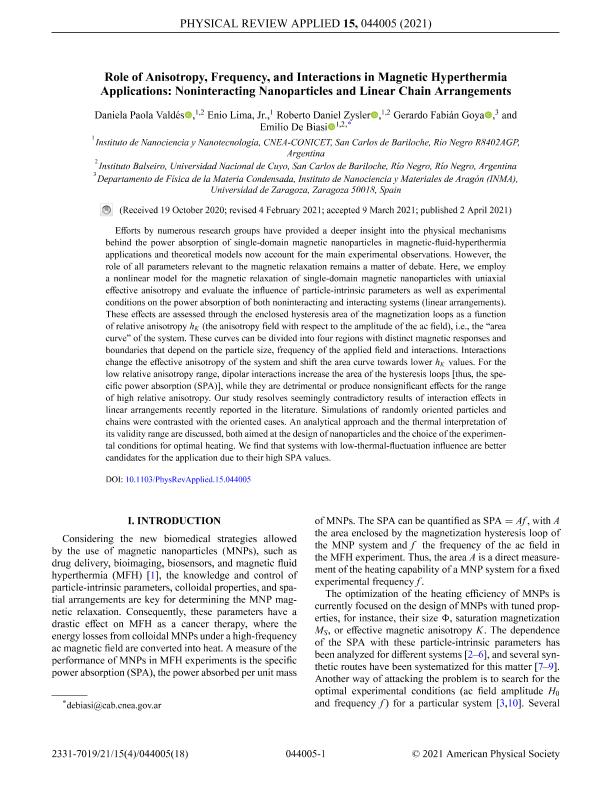Artículo
Role of Anisotropy, Frequency, and Interactions in Magnetic Hyperthermia Applications: Noninteracting Nanoparticles and Linear Chain Arrangements
Valdés, Daniela Paola ; Lima, Enio Junior
; Lima, Enio Junior ; Zysler, Roberto Daniel
; Zysler, Roberto Daniel ; Goya, Gerardo Fabián; de Biasi, Emilio
; Goya, Gerardo Fabián; de Biasi, Emilio
 ; Lima, Enio Junior
; Lima, Enio Junior ; Zysler, Roberto Daniel
; Zysler, Roberto Daniel ; Goya, Gerardo Fabián; de Biasi, Emilio
; Goya, Gerardo Fabián; de Biasi, Emilio
Fecha de publicación:
04/2021
Editorial:
American Physical Society
Revista:
Physical Review Applied
ISSN:
2331-7019
Idioma:
Inglés
Tipo de recurso:
Artículo publicado
Clasificación temática:
Resumen
Efforts by numerous research groups have provided a deeper insight into the physical mechanisms behind the power absorption of single-domain magnetic nanoparticles in magnetic-fluid-hyperthermia applications and theoretical models now account for the main experimental observations. However, the role of all parameters relevant to the magnetic relaxation remains a matter of debate. Here, we employ a nonlinear model for the magnetic relaxation of single-domain magnetic nanoparticles with uniaxial effective anisotropy and evaluate the influence of particle-intrinsic parameters as well as experimental conditions on the power absorption of both noninteracting and interacting systems (linear arrangements). These effects are assessed through the enclosed hysteresis area of the magnetization loops as a function of relative anisotropy hK (the anisotropy field with respect to the amplitude of the ac field), i.e., the "area curve"of the system. These curves can be divided into four regions with distinct magnetic responses and boundaries that depend on the particle size, frequency of the applied field and interactions. Interactions change the effective anisotropy of the system and shift the area curve towards lower hK values. For the low relative anisotropy range, dipolar interactions increase the area of the hysteresis loops [thus, the specific power absorption (SPA)], while they are detrimental or produce nonsignificant effects for the range of high relative anisotropy. Our study resolves seemingly contradictory results of interaction effects in linear arrangements recently reported in the literature. Simulations of randomly oriented particles and chains were contrasted with the oriented cases. An analytical approach and the thermal interpretation of its validity range are discussed, both aimed at the design of nanoparticles and the choice of the experimental conditions for optimal heating. We find that systems with low-thermal-fluctuation influence are better candidates for the application due to their high SPA values.
Palabras clave:
hyphertermia
,
nanoparticles
,
magnetic interactions
Archivos asociados
Licencia
Identificadores
Colecciones
Articulos (UE-INN - NODO BARILOCHE)
Articulos de UNIDAD EJECUTORA INSTITUTO DE NANOCIENCIA Y NANOTECNOLOGIA - NODO BARILOCHE
Articulos de UNIDAD EJECUTORA INSTITUTO DE NANOCIENCIA Y NANOTECNOLOGIA - NODO BARILOCHE
Citación
Valdés, Daniela Paola; Lima, Enio Junior; Zysler, Roberto Daniel; Goya, Gerardo Fabián; de Biasi, Emilio; Role of Anisotropy, Frequency, and Interactions in Magnetic Hyperthermia Applications: Noninteracting Nanoparticles and Linear Chain Arrangements; American Physical Society; Physical Review Applied; 15; 4; 4-2021; 1-18
Compartir
Altmétricas



